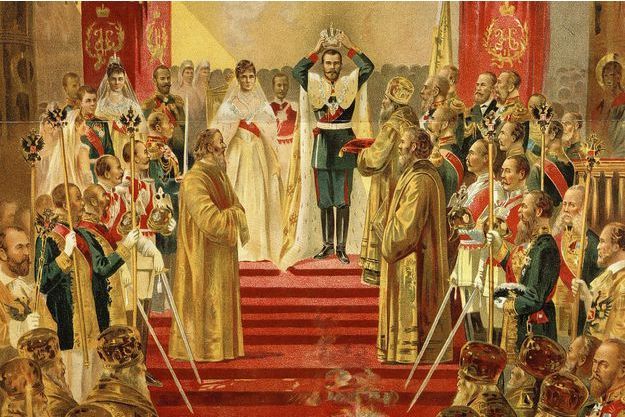Coronation, ‘ideally the process of the creation of the monarch, even though in course of time, through a change in the theory of succession, it may come to be rather the ratification of an accomplished fact than the means of its accomplishment’ (Brightman).
Until the time of Constantine the Great none of the Rom emperors wore a crown; but certain features of their accession deserve notice as having left traces, however faint, in subsequent rites. Theoretically at least the emperor was elected, and the choice, no matter what form it took, was always followed by acclamation, which ratified that choice.
The imperial insignia were (a) the ‘purple’, i.e. the cloak, paluda-mentum of a general on active service, and (b) the laurel wreath. The more or less violent clothing of the new emperor in the purple often constituted a mode of investiture; and his promise in return of a largess to the army and occasionally to the people) became equivalent to formal acceptance of election. Byzantine rites.
Constantine’s assumption of the diadem introduced a new element; according to Aurelius Victor he wore it regularly during life, and it was placed upon his corpse. The diadem thus became the prin mark of sovereignty; but at first there were no prescribed rites for its conferment.
History of Coronation Ceremony of Kings
The first emperor to be crowned in church was Phocas, 612, and from this date the possesses a formal and religious character throughout. The right centred upon the conferment of the chlamys and the crown. Before the imposition of each the Patriarch read in silence a prayer very similar to that found in western Coronation rites of a later period. After the crowning, the people shouted 3 times: ‘Holy! Holy! Holy!’ and ‘Glory to God in the highest and on earth peace!’ The emperor then received communion from the reserved sacrament, or occasionally at Mass of the Presanctified.
The early euchologia, which contain the above ceremony in full detail, make no mention of any rite of unction. This was not introduced into the Byzantine ceremonial until the 12th cent., and even then it was limited to making a cross on the emperor’s head with chrism. At about the same time investiture with the chlamys disappeared; but two special prayers were retained, between which the unction and crowning took place.
On arrival at Westminster Abbey the king straightway made an offering at the high altar. Then, after receiving the acclamations on a raised platform, he was questioned by the archbishop as to his willingness to observe the laws and customs granted by the Confessor, and was required to promise peace for the Church and justice for the people. He confirmed these promises by an oath upon the altar, and then prostrated himself while the Veni Creator and litanies were sung.
Now followed the unction:
while an anthem and long prayers were recited, the king’s hands, breast, shoulder-blades and arm joints were anointed with oil of the cate-chumens; his head, first with this same oil and then with chrism. Next came the vesting and delivery of the insignia. First to be put on was a tunic (colobium sindonis), then sandals with spurs; second, a sword; third, the armlike, a kind of stole passed round the neck and tied to the elbows; fourth, the pallium.
The Holy Roman Empire.
Apart from the Visigothic example mentioned above the earliest recorded instance of the unction of a Christian sovereign in W. Europe is that of Pepin (752). Charlemagne too was anointed at his C. by Pope Leo III (800). In its complete and final form the C. of the Emperor began with his reception by the Pope on the steps of St Peter’s in Rome, where the Sovereign Pontiff sat enthroned, surrounded by his cardinals.
Thus we can conclude The coronation is a ceremony in which a king receives the crown, insignia of sovereignty. This is the central moment of this ceremonial process that is the coronation.
